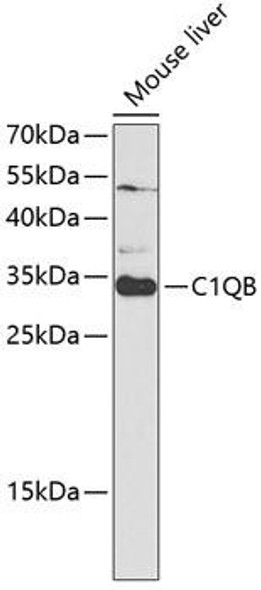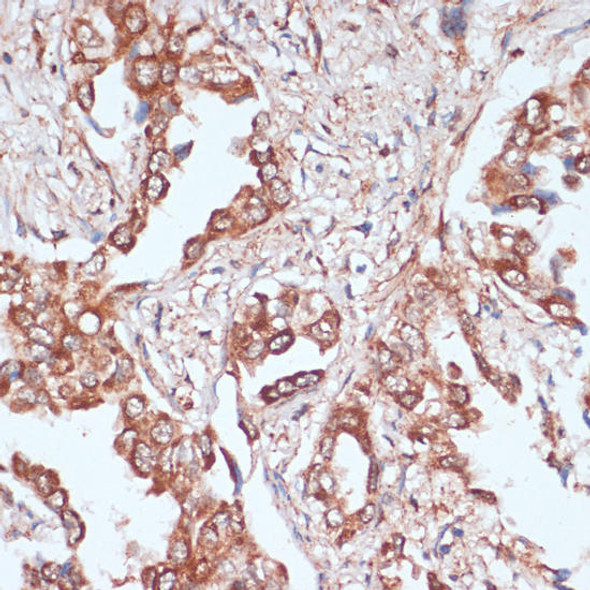Anti-ATP5J2 Antibody (CAB17055)
- SKU:
- CAB17055
- Product type:
- Antibody
- Reactivity:
- Mouse
- Rat
- Host Species:
- Rabbit
- Isotype:
- IgG
- Antibody Type:
- Polyclonal Antibody
- Research Area:
- Metabolism
Frequently bought together:
Description
| Antibody Name: | Anti-ATP5J2 Antibody |
| Antibody SKU: | CAB17055 |
| Antibody Size: | 20uL, 50uL, 100uL |
| Application: | WB |
| Reactivity: | Mouse, Rat |
| Host Species: | Rabbit |
| Immunogen: | A synthetic peptide of human ATP5J2. |
| Application: | WB |
| Recommended Dilution: | WB 1:500 - 1:2000 |
| Reactivity: | Mouse, Rat |
| Positive Samples: |
| Immunogen: | A synthetic peptide of human ATP5J2. |
| Purification Method: | Affinity purification |
| Storage Buffer: | Store at -20°C. Avoid freeze / thaw cycles. Buffer: PBS with 0.02% sodium azide, 50% glycerol, pH7.3. |
| Isotype: | IgG |
| Sequence: | Email for sequence |
| Gene ID: | 9551 |
| Uniprot: | P56134 |
| Cellular Location: | |
| Calculated MW: | |
| Observed MW: | Refer to figures |
| Synonyms: | ATP5J2, ATP5JL |
| Background: | Mitochondrial ATP synthase catalyzes ATP synthesis, utilizing an electrochemical gradient of protons across the inner membrane during oxidative phosphorylation. It is composed of two linked multi-subunit complexes: the soluble catalytic core, F1, and the membrane-spanning component, Fo, which comprises the proton channel. The catalytic portion of mitochondrial ATP synthase consists of five different subunits (alpha, beta, gamma, delta, and epsilon) assembled with a stoichiometry of 3 alpha, 3 beta, and single representatives of the gamma, delta, and epsilon subunits. The proton channel likely has nine subunits (a, b, c, d, e, f, g, F6 and 8). This gene encodes the f subunit of the Fo complex. Alternatively spliced transcript variants encoding different isoforms have been identified for this gene. This gene has multiple pseudogenes. Naturally occurring read-through transcription also exists between this gene and the downstream pentatricopeptide repeat domain 1 (PTCD1) gene. |
| UniProt Protein Function: | ATP5J2: Mitochondrial membrane ATP synthase (F(1)F(0) ATP synthase or Complex V) produces ATP from ADP in the presence of a proton gradient across the membrane which is generated by electron transport complexes of the respiratory chain. F-type ATPases consist of two structural domains, F(1) - containing the extramembraneous catalytic core and F(0) - containing the membrane proton channel, linked together by a central stalk and a peripheral stalk. During catalysis, ATP synthesis in the catalytic domain of F(1) is coupled via a rotary mechanism of the central stalk subunits to proton translocation. Part of the complex F(0) domain. Minor subunit located with subunit a in the membrane. Belongs to the ATPase F chain family. 2 isoforms of the human protein are produced by alternative splicing. |
| UniProt Protein Details: | Protein type:Energy Metabolism - oxidative phosphorylation; Hydrolase; Mitochondrial Chromosomal Location of Human Ortholog: 7q22.1 Cellular Component: proton-transporting ATP synthase complex, coupling factor F(o); mitochondrial inner membrane; integral to membrane; nucleus; mitochondrial proton-transporting ATP synthase complex Molecular Function:ATPase activity; transmembrane transporter activity Biological Process: cellular metabolic process; proton transport; mitochondrial ATP synthesis coupled proton transport |
| NCBI Summary: | Mitochondrial ATP synthase catalyzes ATP synthesis, utilizing an electrochemical gradient of protons across the inner membrane during oxidative phosphorylation. It is composed of two linked multi-subunit complexes: the soluble catalytic core, F1, and the membrane-spanning component, Fo, which comprises the proton channel. The catalytic portion of mitochondrial ATP synthase consists of five different subunits (alpha, beta, gamma, delta, and epsilon) assembled with a stoichiometry of 3 alpha, 3 beta, and single representatives of the gamma, delta, and epsilon subunits. The proton channel likely has nine subunits (a, b, c, d, e, f, g, F6 and 8). This gene encodes the f subunit of the Fo complex. Alternatively spliced transcript variants encoding different isoforms have been identified for this gene. This gene has multiple pseudogenes. Naturally occurring read-through transcription also exists between this gene and the downstream pentatricopeptide repeat domain 1 (PTCD1) gene. [provided by RefSeq, Nov 2010] |
| UniProt Code: | P56134 |
| NCBI GenInfo Identifier: | 51479129 |
| NCBI Gene ID: | 9551 |
| NCBI Accession: | NP_001003713.1 |
| UniProt Secondary Accession: | P56134,O76079, Q6IBB3, Q96L83, Q9BTI8, C9J8H9, F8W7V3 |
| UniProt Related Accession: | P56134 |
| Molecular Weight: | |
| NCBI Full Name: | ATP synthase subunit f, mitochondrial isoform 2b |
| NCBI Synonym Full Names: | ATP synthase, H+ transporting, mitochondrial Fo complex, subunit F2 |
| NCBI Official Symbol: | ATP5J2 |
| NCBI Official Synonym Symbols: | ATP5JL |
| NCBI Protein Information: | ATP synthase subunit f, mitochondrial |
| UniProt Protein Name: | ATP synthase subunit f, mitochondrial |
| UniProt Gene Name: | ATP5J2 |
| UniProt Entry Name: | ATPK_HUMAN |











